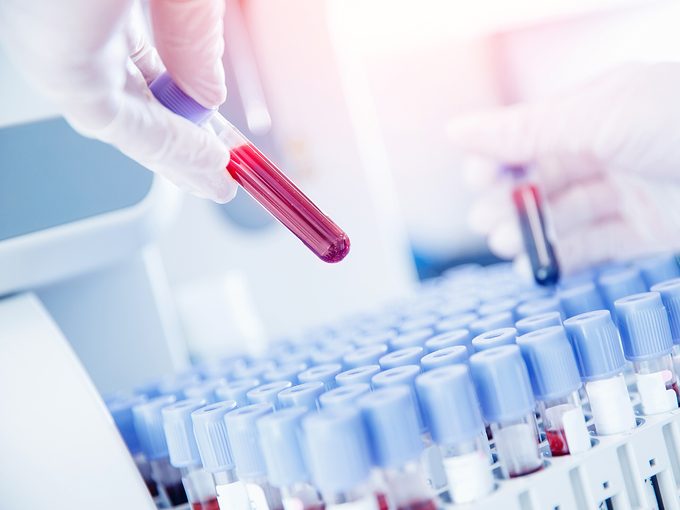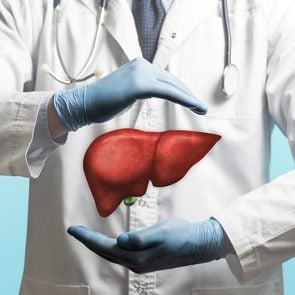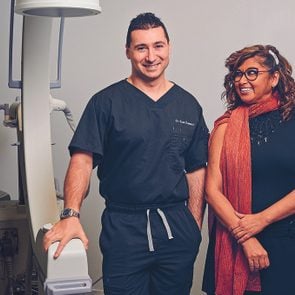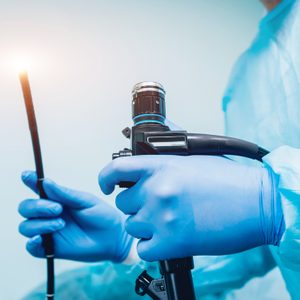This Simple Blood Test Could Detect 50 Types of Cancer
...And more exciting breakthroughs in the fight against cancer.

Cancer Research That Offers Real Hope
A cancer diagnosis no longer means what it used to. Just a few decades ago, the survival rate beyond five years was less than 50 per cent. Now, nearly 70 per cent of those who get cancer survive that long, and that proportion is set to rise. Why? Because more than ever, chemotherapy and radiation, once the only heavy hitters of cancer treatment, are being paired with or replaced by a slate of new drugs and treatments.
For example, the first-ever medication for what was previously considered an “undruggable” lung cancer mutation was recently approved in the United States, Europe, the United Kingdom and Canada. And a new precision chemotherapy drug delivered directly to breast cancer tumour cells is giving hope to patients with the aggressive HER2-positive form of the disease.
An even bigger newsmaker has been cancer immunotherapy. Researchers have found ways to harness the body’s immune system to fight cancer cells. “We’re truly living in the age of immunotherapy cancer treatment,” says Nigel Brockton of the American Institute for Cancer Research.
Also fuelling optimism is a focus on prevention. Decades of research and public education have led to greater awareness of how lifestyle changes can reduce our risk of developing cancer. According to the American National Institute of Health, 90 to 95 per cent of cancers can be attributed to things we can control, rather than genetic factors.
Here are some of the ways we’re winning the battle against cancer.

Cancer Prevention
HPV Vaccine
Cervical cancer was once one of the most common women’s cancers and the leading cause of cancer deaths among women. In recent decades, Pap test screening led to a decline in the cancer. But a preventive tool in use for more than a decade—a vaccine against the human papilloma virus (HPV), which is responsible for more than 95 per cent of cervical cancer cases—has been a game-changer. Here’s how:
- Since 2006, when the vaccine was introduced in North America, HPV infections have dropped more than 80 per cent among teen girls and young women in the United States.
- A study published in The Lancet at the end of 2021 found that in England, where the immunization program was introduced in 2008 (the same year it started in Europe), cervical cancer has been almost completely eliminated in women born since 1995, who were vaccinated at ages 12 or 13.
- A 2020 Swedish study of 1.7 million women published in the New England Journal of Medicine indicates that women vaccinated as teens were 90 per cent less likely to get cervical cancer.
- And in March 2022, Australia announced it is on track to become the first country to eliminate the cancer.
The WHO’s goal is for 90 per cent of girls to be vaccinated globally by the year 2030, eventually eliminating cervical cancer entirely.
mRNA Cancer Vaccines
The speedy development of Covid-19 vaccines was thanks to groundwork already done by researchers creating mRNA vaccines to fight cancer. These vaccines use a specially programmed molecule to activate an immune response in the body’s cells. Unlike the Covid-19 vaccines used to immunize billions of people, each cancer mRNA vaccine is tailor-made to treat a single patient’s cancerous tumours. Dozens of clinical trials testing their effectiveness against a range of cancers, including pancreatic, are underway.
“In theory,” says Dr. Patrick Ott, director of the Center for Personal Cancer Vaccines at the Dana-Farber Cancer Institute in Boston, “this personalized approach can be taken for everyone, and for every cancer.”

Cancer Screening Breakthroughs
Galleri Blood Test
Catching cancer early can be challenging. The screening methods in wide use—e.g., the mammogram since the 1970s and the colonoscopy since the 1990s—look for one type of cancer.
And blood tests look for markers like blood cell count, proteins and chemicals made by cancer cells, but are not highly specific; they are often used only after cancer has been detected by another method.
Now, a test known as Galleri, made by California-based biotechnology company GRAIL, promises to detect more than 50 types of cancer with one blood sample. Galleri finds tumour-generated genetic material in the blood; it reveals the presence of cancer and where it originated. In a study published in the Annals of Oncology in June 2021, researchers found the test detected cancers more than half of the time, and predicted a cancer’s origin with 89 per cent accuracy.
The test holds particular promise for cancers like pancreatic and ovarian, so deadly because symptoms are elusive and there are no other screening methods. Galleri is available by prescription in the U.S., but isn’t yet approved in the E.U. In June 2022, the U.K.’s National Health Service announced a massive trial of 140,000 participants to assess Galleri’s effectiveness.

Breakthroughs in Cancer Treatments
Enhertu
Though breast cancer mortality rates have been falling for three decades, it’s still the most common cancer in the U.S. (excluding non-melanoma skin cancers) and in Europe. Among the deadliest type are those in which the tumours overproduce a protein called HER2. Affecting about one in five breast cancer patients, this type usually grows and spreads faster than other breast cancers—and is more likely to return after treatment.
But in 2021 in Europe, Canada and the U.K., and in 2019 in the U.S., Trastuzumab deruxtecan (brand name: Enhertu) was approved. The precision chemotherapy drug dramatically slows progress of this aggressive cancer.
“This is very important,” says Dr. Rebecca Roylance, a medical oncologist at the University College London Hospital. Roylance specializes in breast cancer and was involved in administering the U.K. trials of Enhertu. “A drug that is well tolerated is so important to improve patients’ quality of life despite the impact of their cancer and treatment.”
It works by transporting a chemotherapy drug directly to HER2 tumour cells to destroy them. Enhertu delivers more than double the chemo payload of existing treatments, and also destroys nearby cancerous cells. An international trial published in the New England Journal of Medicine in July of this year showed that patients taking Enhertu went a median of 10 months without tumour growth compared to about five months with the current standard treatment.
Find out how to lower your breast cancer risk.
Lumakras
Lung cancer is the leading cancer killer in Europe, causing 20 per cent of cancer deaths. It’s the top cancer killer in Canada and the U.S., too, accounting for almost a quarter of cancer deaths in the U.S. Until very recently, there were no drugs to treat lung cancers caused by a dangerous mutation in the KRAS G12C gene.
The mutation, which causes the cancerous cells to duplicate wildly, affects about 13 per cent of patients with the most common lung cancer. The only treatment has been additional chemotherapy, which might give patients a few more months to live, at most.
A new KRAS-inhibiting drug could transform that prognosis. Results of a phase-one trial published in June 2021 in the New England Journal of Medicine are promising. Patients previously treated with both chemotherapy and immunotherapy took a daily Sotorasib pill (brand name Lumakras in North America and Lumykras in Europe; both have been recently approved). Around 40 per cent of patients experienced tumour shrinkage of 30 per cent or more. And according to a recent update, one in three was still alive two years after starting treatment.
“It offers hope to patients whose prognosis is grim,” says Dr. Ferdinandos Skoulidis, an oncologist at the MD Anderson Cancer Center at the University of Texas and the lead author of the groundbreaking study. “It’s a hugely important discovery.”
Immunotherapy
Immunotherapy alters cells in the body’s immune system, allowing them to recognize and fight cancer cells. The field is barely a decade old, yet it dominates cancer research: Nearly 5,000 immunotherapy cancer trials are being conducted worldwide.
“There has been a revolution in the treatment of several cancer types in recent years thanks to immunotherapies,” says Dr. Marco Donia, a scientist at Denmark’s National Center for Cancer Immune Therapy.
The field is so groundbreaking that in 2018, immunologists James P. Allison of the U.S. and Tasuku Honjo of Japan were awarded the Nobel Prize in Medicine for their discovery of the principle behind immune checkpoint inhibitors (ICIs), the most common type of immunotherapy cancer treatment used today.
The treatment, administered intravenously, is used against many cancers but is particularly successful against lung, skin and some colon cancers. The effects of ICIs can last long after treatment ends. A 2021 survey of progress made in the treatment of melanoma published in the journal Cancers reports that ICI combination therapy results in long-term survival for more than half of metastatic melanoma patients.
“This is the first time we’re seeing solid cancers with a six-month median survival rate essentially being cured,” says Donia. (“Solid” cancers are those with tumour masses as opposed to “liquid” cancers, such as those that occur in blood.)
Another type of immunotherapy, called CAR T-cell therapy (or adoptive cell transfer), also shows great promise. The personalized immunotherapy, first used in 2017, involves extracting some disease-fighting white T-cells from a patient’s blood, genetically engineering them to recognize and target a specific cancer protein, and reintroducing them into the patient’s bloodstream. Then they circulate, attack and destroy cancer cells. The therapy has been shown to add years of life for people with blood cancers.
The treatment has been approved for specific types of adult lymphoma and child and youth leukemia in Europe, the U.S., and Canada, but because it is so individually tailored, CAR T-cell therapy is used relatively rarely, and it’s expensive. Researchers are investigating development of universal CAR T-cell therapy.
In Canada, a national trial of CAR T-cell therapy is underway. Results so far have been promising: for 13 of the 30 people enrolled, cancer cells can no longer be detected in their blood, according to Dr. Natasha Kekre, a scientist and hematologist at the Ottawa Hospital and the trial’s principal investigator.
Says Kekre: “This will allow us to cure so many people.”
Next, check out 20 symptoms you should never ignore.






